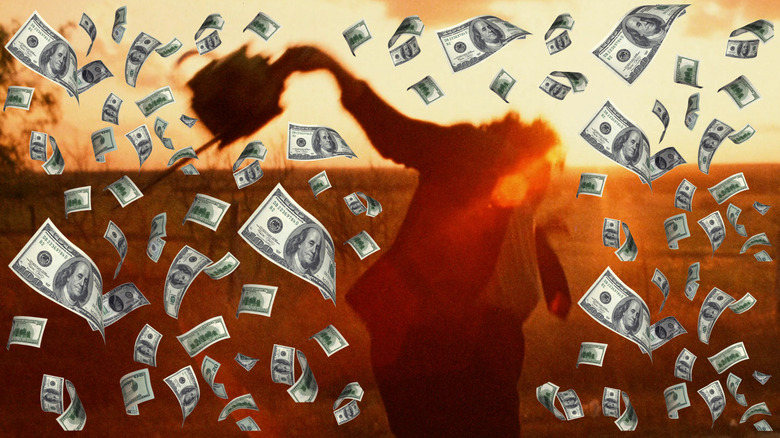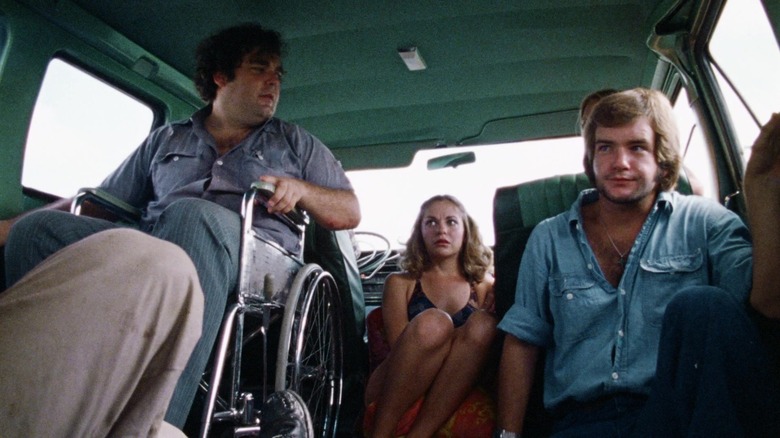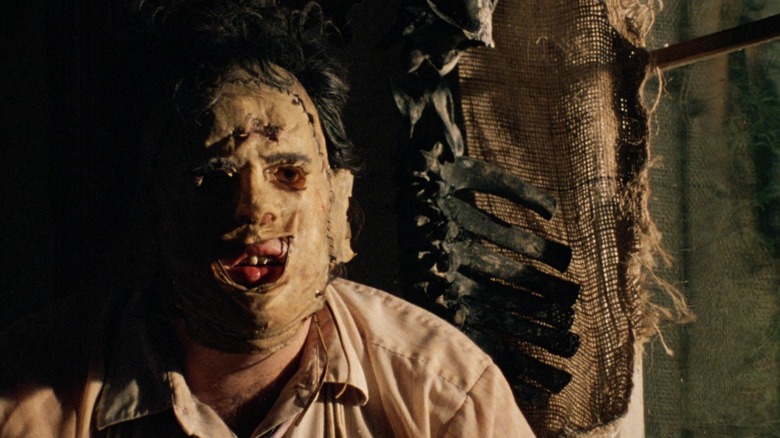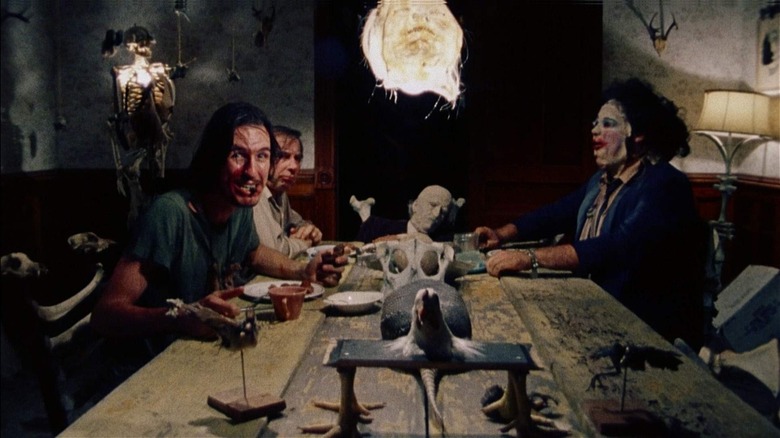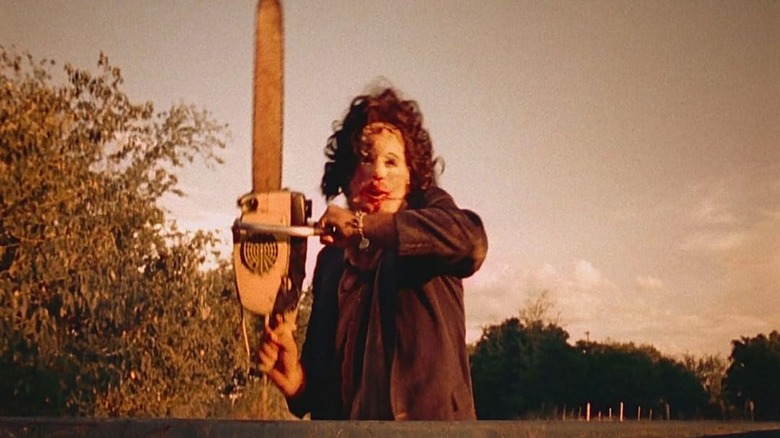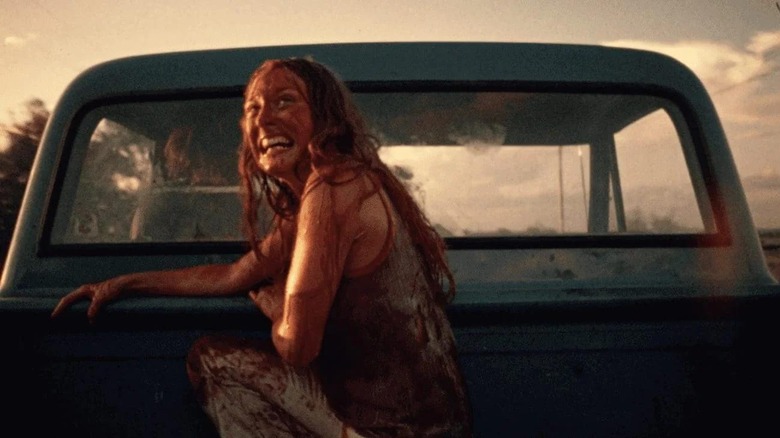50 Years Ago, One Of The Most Important Horror Movies Ever Cut It Up At The Box Office
(Welcome to Tales from the Box Office, our column that examines box office miracles, disasters, and everything in between, as well as what we can learn from them.)
"I remember the screams in the theater. People walked out. But the audience that stayed was hooked." Those are the words of Gunnar Hansen, the man behind Leatherface, writing in his book "Chain Saw Confidential" about how audiences reacted to director Tobe Hooper's "The Texas Chain Saw Massacre" in 1974. Hooper, for his part, had become bored with the horror genre and " set out as a fan of the genre to do something that gave you [...] your money's worth," as he put it in an interview with NPR in 2017. Safe to say, mission accomplished.
50 years later, Hooper's feature directorial debut is one of the most celebrated horror films in cinema history. It's also one of the movies that indie filmmakers look to as a guiding light when they tell themselves "it can be done." Hooper made his all-time slasher classic with minimal resources in punishing conditions. Maybe the cast and crew hated him by the end of it. Maybe they all left with injuries. But they left greatness in their wake, and that means something.
In this week's Tales from the Box Office, we're looking back at "The Texas Chain Saw Massacre" in honor of its 50th anniversary. We'll go over how it came to be, the unforgivably harsh conditions the film was made under, what happened when it hit theaters, what happened in the years that followed, and what lessons we can learn from it five decades later. Let's dig in, shall we?
The movie: The Texas Chain Saw Massacre
The film as we know it centers on Sally (Marilyn Burns), who is heading to investigate her grandfather's grave alongside her paraplegic brother, Franklin (Paul A. Partain). Along with a group of friends in a van, they set out on a road trip across Texas. After a forced detour, however, they discover a group of twisted, murderous outcasts. Things get bloody and horrifying from there.
Hooper wrote the script alongside Kim Henkel, with "Texas Chain Saw Massacre" ultimately serving as something of a disturbing take on "Hansel & Gretel," with the duo also taking inspiration from real-life serial killer Ed Gein. At first though, Hooper only knew that he wanted to write something involving a group of young people struggling with the environment that was the 1970s. So, how did chainsaws come into the equation? In a 2014 interview, Hooper explained that it all started with a crowded department store:
"There were thousands of people in there, and I was weaving through them to get out, and I found myself in the hardware department, I looked down and there was a rack of chainsaws in front of me for sale."
This wasn't an idea that Hollywood would fund, so Hooper and Henkel had to scrape together what they could. They formed a company called Vortex Inc. and raised $60,000, mostly from Bill Parsley, a former member of the Texas Legislature. Even when accounting for inflation, that is a shoestring budget. That meant working with largely unknown actors and filming with a ragtag crew. That budget also meant having to get wildly creative to save money.
"Some of the skeletons were real," Hooper said of the bones in "Texas Chain Saw" in a 2014 interview. Why, exactly? "It was less expensive to get real human skeletons from India than to buy plastic reproductions." As extreme and bizarre as that sounds, it's only the tip of the iceberg when it comes to what this group endured in the pursuit of making what many consider to be the first true slasher film.
Shooting Texas Chain Saw was gross and bloody for real
Put lightly, filming "The Texas Chain Saw Massacre" was a nightmare. From 16-hour filming days, every day, to suffering in the sweltering heat of Round Rock, Texas just outside of Austin, it was miserable for all involved. The production used 16mm cameras which saved money, but also had a less-polished look than 35mm offered at the time. In the end, that contributed to the film's grimy, dirty look.
It wasn't just the heat and the long hours either. There were also some pretty disgusting things going on behind-the-scenes. For instance, many of the dead animals featured on screen? They are real. As Hooper explained in a 2015 interview:
"The day of shooting the dinner scene, a big dump truck pulls up at the house. It had one of these hydraulic beds and they dump all of these animal cadavers at the back of the house. A hundred at least. Dogs, cats, everything. They came from the city pound and had just been euthanized. It totally freaked everyone out, including me."
On a studio production, this would never fly. But this was punk rock, down-and-dirty indie filmmaking, for better or worse. Speaking of worse, it wasn't just actual rotting flesh that made conditions on set especially gross. As Hansen recalled in a 1987 interview, the actor's costumes got especially smelly as well:
"Sometimes shooting sessions dragged on for more than 26 hours. Since we all had only one set of clothes for the movie, it was too much of a risk to get them washed; the colors might change. After a few weeks of shooting, it was a little more than 'fright' that made us keep our distance from each other."
Hansen being in a full body suit with a mask in temperatures over 100 degrees is beyond absurd. The smell must have been unimaginable. To make matters worse, the actors were only being paid very little up front, with the promise of more once the film eventually sold to a distributor. Meanwhile, Hansen and everyone else quite literally suffered for Hooper's art, with just about everyone sustaining injuries during filming. While it surely wouldn't have been of much comfort at the time, at the very least, they weren't suffering for naught.
The financial journey
During post-production, extra costs were incurred, which meant that Hooper had to find additional funding. This also meant giving up more pieces of the pie that he and Henkel had carved out with Vortex Inc. early on in the process. While figures vary wildly, the total cost of the production is believed to be in the $140,000 range, or a little over $900,000 in today's dollars. Even with that, we're looking at an impressively cheap movie.
After some difficulties, the now-defunct Bryanston Distributing Company offered to distribute the film, which further cut into future profits meant to be shared with the cast, crew, and the investors. "The Texas Chain Saw" massacre was then marketed falsely as a "true story," with John Larroquette providing some now-legendary voice over to help set the stage for what was to follow in the film. That all helped drum up an audience.
The film premiered on October 1, 1974, in Austin, Texas. It later went on to screen at theaters across the country. "It was released and it jumped up on the charts, although the releasing pattern in those days was quite different than it is today," Hooper noted in a conversation with Film Vault in 1998. Indeed, things were very different back then. Films wouldn't just open on thousands of screens with massive marketing campaigns. Oftentimes, it was a slow build.
Over the years, the film continued to play in theaters in North America while also drumming up controversy. It was banned in theaters in various states in the U.S. and lambasted for its over-the-top violence. Still, audiences kept seeking it out, with "Chain Saw" eventually pulling in more than $30.8 million in the U.S. alone. It was one of the 20 highest-grossing movies released in 1974 overall, amazingly enough. Again, exact figures are tough to come by, but it's believed the film has made $50 million or more globally since its original release. That's not a bad return on investment, to put it mildly.
Leatherface earns eternal life beyond the box office
One thing is certain: "The Texas Chain Saw Massacre" made a lot of money. Who made all of that money? That's a much larger issue perhaps for another time. Larroqutte was originally paid in weed, as he confirmed to Parade in 2023. He eventually made some actual money too. Because of the deals that were struck to cobble together the financing and distribution, there have been squabbles over who got what, and who gets what now. It matters because, to this day, there is merchandise, VOD, every version of home media, cable, and other revenue streams to worry about. This movie has gained eternal life, which means it generates eternal revenue.
It became clear just how much the film's impact had grown in the years after its initial release when the low-budget slasher that could eventually spawned a nine-film franchise. In 1986, Hooper returned for "The Texas Chainsaw Massacre 2," which is utterly outlandish and held in high regard by a great many fans. It also paved the way for a series of sequels and spin-offs to follow.
As far as profitability goes, the 2003 "Texas Chainsaw Massacre" remake cashed in big on the early 2000s slasher trend, pulling in $108 million worldwide. Most recently, Netflix released "Texas Chainsaw Massacre" (no "The") in 2022, which served as a direct sequel to Hooper's original film. As of yet, no sequel has been confirmed but, at this point, Leatherface only ever stays dead for so long. He has become a true icon of the genre, right alongside Michael Myers, Jason Voorhees, and Freddy Krueger.
More than anything, circling back to the film in question, "The Texas Chain Saw Massacre" has earned a reputation as an important piece of cinema — not just a profitable one. Its praises have been sung far and wide, even if many chastised it in the '70s as too violent or trashy. What's most impressive is how well the film stands up to modern scrutiny. Oftentimes, old horror films can be appreciated by modern viewers, but they run the risk of looking dated or showing their age.
This film, on the other hand, still packs a punch 50 years later, which speaks volumes for what Hooper and his team were able to accomplish with so little, under such dreadful conditions. They suffered for a form of eternal life.
The lessons contained within
This is one of those situations where extracting a lesson from it is crystal clear. I'm no filmmaker and have never aspired to be one. But for anyone who has dreams of doing such things? "The Texas Chain Saw Massacre" is one of the purest examples of just going and making your thing, doing it cheap if you must, and good things can happen. Mind you, Hooper and his crew did this when film was more expensive and there were more gatekeepers in distribution. In theory, anyone could get some attachments for an iPhone and upload the movie online, if all else fails.
This is right up there with Kevin Smith making "Clerks" on a shoestring budget with money from maxing out credit cards. That bold move launched a career that is still going to this very day, with Smith recently releasing his latest film, "The 4:30 Movie." It's also cut from the same cloth as Robert Rodriguez's "El Mariachi," which was made for an astoundingly low $7,000 and launched not just a trilogy, but also a hugely rich Hollywood career. While Hooper's horror classic wasn't nearly as cheap, it's still a movie made with that similar can-do spirit.
It also gets at that age-old thing of horror, for whatever reason, almost never getting the respect it deserves. "The Exorcist" still stands as the most well-respected horror movie ever made, but that sadly remains an exception and is unbelievably far from the rule. Sure, every so often something like "Get Out" comes along, but what about everything in between? Hooper crafted something bold that has had more influence and staying power than many, many films that have won Best Picture in the last 50 years.
This is a shining example of why Hollywood and pundits would do well to embrace horror more frequently and not just "prestige" examples of the genre. As this film proved handily, eventually, everyone who condemned the film as exploitative trash ended up looking silly. It's better to be on the right side of history.
